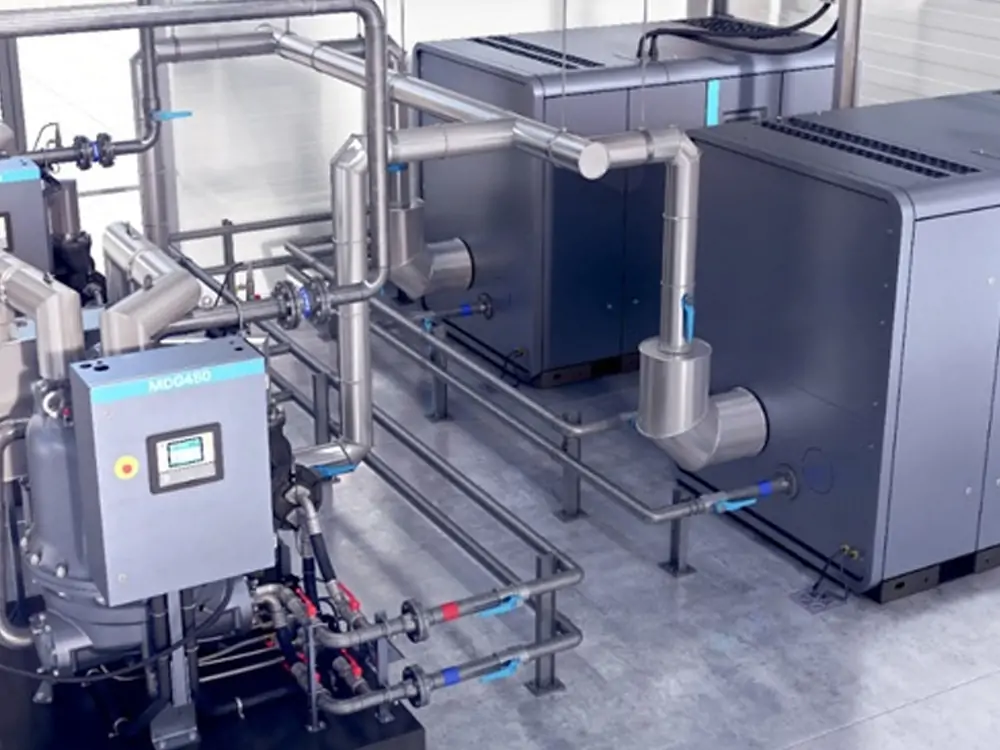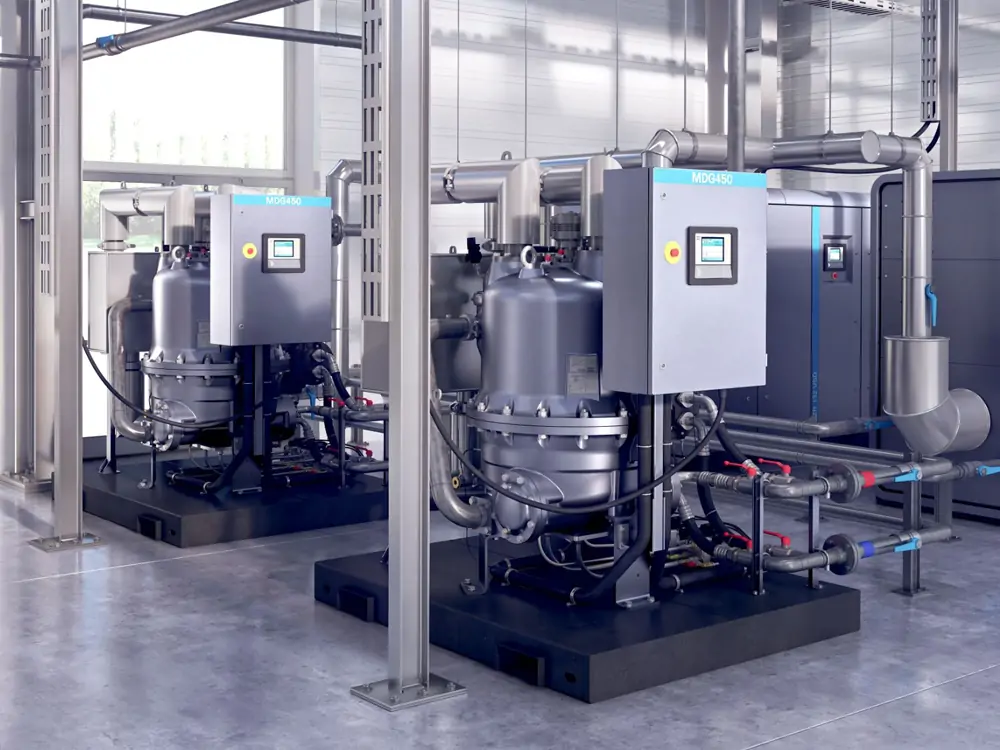Air compressor dryer is an essential element of compressed air systems. Inevitably, there will be moisture during the operation of the air compressor. It can contaminate the end product and damage our production equipment and components. This is why it must remove this moisture in the compressor system. Compressed air dryers are the devices that help dry the wet air. This guarantees the quality of your compressed air. But to you, what is the best air dryer for air compressors? And how to select them?
Whether you are an engineer, technician, or manufacturer, this article will provide in-depth insights and guidance on this critical topic. Let’s choose the right drying solution for your air compression system.
How Do You Select The Air Dryer For Air Compressor
It must know the following parameters to choose the right compressed air dryer. Let’s talk about it.
Air Capacity
The air compressor dryer can handle this maximum flow of compressed air. Firstly, the user needs to determine this value based on the consumption of all air-consuming equipment and the usage factor. Of course, if you already have an air compressor, you can send the nameplate to the manufacturer.
As a professional air compressor dryer manufacturer, we tell you responsibly. If you use a lot of air, choose a compressed air dryer with a larger capacity. That is, the air capacity of the dryer should be greater than that of the air compressor. Because in times of high temperature and humidity, the water content of the air increases. At this time, the dryer machine is overloaded. So, the drying effect will decrease. This can cause many problems, such as large amounts of moisture and equipment breakdown.
Inlet Air Pressure
Different air pressures and different air capacities of the dryer. The common pressures in industrial production range from 0.6MPa to 1.0MPa. So, the most common is the normal pressure air compressor air dryer.
However, other industries have different pressure requirements. For example, the laser industry generally requires 16 bars. Some industries require high-pressure compressed air dryers. Our company can customize dryers up to 100 bar.
Inlet Air Temperature And Ambient Temperature
Temperature is critical to the choice of air compressor dryer. For example, there are two types of refrigerated air dryers. Namely normal temperature (50°C) and high temperature (80°C). The temperature is very high in Pakistan and the Middle East in summer. First, it must choose a high-temperature type of refrigerant dryer. Moreover, we often need to choose a larger model. This not only achieves good water removal but also avoids dryer downtime.
On the other hand, the inlet air temperature of the desiccant air dryer should generally not be greater than 40°C. If the temperature is too high, the water removal effect of the adsorbent will be greatly reduced. Of course, it can choose the HOC type desiccant dryer now.
Dew Point Requirement of Air Compressor Dryer
Different dew point requirements and different equipment configurations. Naturally, the price is different. Refrigerated dryers generally have a pressure dew point of 2 to 10°C. There are different conditions and different dew points. For example, refrigerant compressed air dryers can achieve a very low dew point. But it requires a standard operating condition of 25°C and 7 bar.
Different industries have different requirements for dew points. The following are some examples.
- Pharmaceutical industry: dew point is at least -40°C.
- PCB industry: dew point needs to reach -20°C.
- Gas air separation industry: dew point requires to be -70°C.
Choose a combination dryer if you require a dew point of -70°C. Or there must be a refrigeration dryer and filters before adsorption air dryer.
Voltage And Frequency
It varies from country to country. For example, in North America, 220V/60HZ/single-phase and 380V/60HZ/3-phase are common. At this moment, it needs to customize the refrigerant compressor. Sometimes the dyer price will also be different.
Raw Materials
Some industries have requirements for the material of air compressor dryers. For example, the pharmaceutical industry requires stainless steel. In this case, the piping and heat exchange system must be SS304. And the adsorption tower also needs SS304. In addition, the lithium battery industry also requires stainless steel.
The stainless steel dryer will be more expensive. Of course, you can choose the Lingyu PD series refrigerated air dryer. You can also choose the modular desiccant compressed air dryer. They can also meet the requirements of food and pharmaceutical industries.
Environmental Requirements
The usual refrigerant of refrigerant air dryers is R22. It is common in developing countries. However, European and American countries require eco-friendly refrigerants. For us, R134a, R407C, R410a are available. The dryer is a little more expensive if you want an eco-friendly refrigerant.
Air Cooled vs. Water Cooled Refrigerated Compressor Air Dryer
Small flow refrigerant air dryer is air cooled. Our air-cooled dryer can be up to 120 m³/min. If above 120 m³/min, the air compressor air dryer is water-cooled.
For high-flow dryers, the size will be very large if you need an air-cooled type. For example, it will be as high as several floors. And the heat exchange efficiency will be much worse. The water-cooled dryer is not affected by a high-temperature environment. Of course, there needs to be a cooling water system. So this will add cost.
Energy Saving Requirements
① Fixed vs. Variable Frequency Refrigerated Air Dryer
We commonly use fixed-frequency air compressor dryers. It can meet the maximum output. However, in actual production activities, the air demand varies. At small demands, it still works at maximum output. This leads to a waste of energy. On the contrary, the output of the variable frequency dryer can match the air demand. This results in significant energy and operation cost savings.
② Choice of Desiccant Dryer Regeneration Method
The heatless compressed air dryer has a small power of ~0.1 kW. But it has a big air consumption of about 15%. This is high energy consumption. Micro-heated desiccant dryer generally consumes about 8% of regeneration air. Compared to the heatless dryer, it can save 40% of energy.
The zero air loss desiccant dryer consumes 0% regeneration air. A heatless air compressor air dryer can save 70% of energy. Of course, it is more expensive.

How to Size The Air Dryer For Air Compressor?
Sizing an air dryer for air compressor involves determining the appropriate capacity and specifications of the dryer. So it can remove moisture and contaminants from the compressed air effectively. The sizing process ensures that the air dryer can handle the air volume and achieve the desired dew point, maintaining the compressed air quality.
Here are the steps to size an air compressor air dryer.
Determine Compressed Air Flow Rate (CFM)
Measure or calculate the maximum compressed air flow rate that your air compressor system requires. This is usually expressed in cubic feet per minute (CFM). It is a crucial parameter for sizing the air dryer.
Calculate Inlet Air Temperature And Pressure
Determine the temperature and pressure of the compressed air at the dryer’s inlet. This information is necessary to calculate the corrected flow rate and dew point.
Consider Ambient Conditions
Account for variations in ambient temperature and humidity, as these can affect the performance of the air dryer. Understanding the environmental conditions helps in selecting the appropriate dryer type and specifications.
Determine Required Dew Point
Define the desired dew point or moisture level for your application. The dew point is the temperature at which air becomes saturated with moisture and starts to condense. Choosing a dew point suitable for the application is crucial to prevent potential issues.
Select The Right Type of Compressed Air Dryer
Choose the appropriate type of air dryer based on the required dew point and application. Common types include refrigerated dryers, desiccant dryers, and membrane dryers. Each type has specific advantages and is suitable for different dew point requirements.
Calculate The Corrected Flow Rate
Adjust the compressed air flow rate for the actual conditions using the information gathered earlier. Correcting for temperature and pressure ensures that the air dryer is sized accurately.
Consult Manufacturer Specifications
Refer to the manufacturer’s specifications and performance data for the selected air dryer type. So it can verify that it can handle the corrected flow rate and achieve the desired dew point.
Account For Safety Factors
Consider adding a safety factor to ensure the air dryer can handle variations in air demand and operating conditions, providing a buffer for unexpected fluctuations.
Choose The Appropriate Air Dryer Size
Based on the corrected flow rate, dew point requirements, safety factors, and manufacturer specifications, select the suitable size and model of the air dryer that meets the system’s needs.
Installation And Monitoring
Install the chosen air dryer correctly within the compressed air system. Regularly monitor its performance and maintain it according to the manufacturer’s recommendations to ensure optimal efficiency and reliability.

Conclusion
In modern industry, compressed air dryers are an indispensable tool. They provide continuous and stable high-pressure air for a variety of applications. However, to ensure reliable operation and extend the compressor’s life, air quality management becomes critical. Selecting and sizing the right compressor air dryer is one of the important steps in ensuring good operation.
By following these steps and considering the specific requirements of your air compressor dryer system, you can accurately size an air dryer to maintain the desired air quality and enhance the overall efficiency of the compressed air dryer system.
